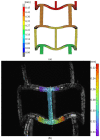Two-Step Geometry Design Method, Numerical Simulations and Experimental Studies of Bioresorbable Stents
- PMID: 35407718
- PMCID: PMC8999420
- DOI: 10.3390/ma15072385
Two-Step Geometry Design Method, Numerical Simulations and Experimental Studies of Bioresorbable Stents
Abstract
The stent-implantation process during angioplasty procedures usually involves clamping the stent onto a catheter to a size that allows delivery to the place inside the artery. Finding the right geometrical form of the stent to ensure good functionality in the open form and to enable the clamping process is one of the key elements in the stent-design process. In the first part of the work, an original two-step procedure for stent-geometry design was proposed. This was due to the necessary selection of a geometry that would provide adequate support to the blood-vessel wall without causing damage to the vessel. Numerical simulations of the crimping and deployment processes were performed to verify the method. At the end of this stage, the optimal stent was selected for further testing. In addition, numerical simulations of selected experimental tests (catheter-crimping process, compression process) were used to verify the obtained geometrical forms. The results of experimental tests on stents produced by the microinjection method are presented. The digital image correlation (DIC) method was used to compare the results of numerical simulation and experimental tests. The two-step modeling approach was found to help select the appropriate geometry of the expanded stent, which is an extremely important step in the design of the crimping process. In the part of the paper where the results obtained by numerical simulation were compared with those gained by experiment and using the DIC method, a good compatibility of the displacement results can be observed. For both longitudinal and transverse (pinch) stent compression, the results practically coincide. The paper presents also the application of the DIC method which significantly expands the research possibilities, allowing for a detailed inspection of the deformation state and, above all, verification of local dangerous areas. This approach significantly increases the possibility of assessing the quality of the stents.
Keywords: bioresorbable stents; digital image correlation; numerical simulation; two-step modeling.
Conflict of interest statement
The authors declare no conflict of interest.
Figures



















References
Grants and funding
LinkOut - more resources
Full Text Sources

